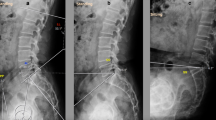Abstract
Introduction
In total hip arthroplasty (THA), acetabular component orientation has critically important effects on dislocation, range of motion, polyethylene wear, pelvic osteolysis, and component migration. The differences in the pelvic orientation in the intraoperative lateral position for insertion of acetabular component during operation and that in the postoperative supine position for evaluation of acetabular component orientation will be one of the factors, which make outliers in acetabular component orientation. We compared acetabular component orientation between intraoperative lateral position and postoperative supine position in 100 consecutive primary THAs.
Materials and methods
A total of 100 consecutive primary THAs (between October 2004 and December 2005) in 100 patients performed by a single surgical team were investigated. Intraoperative anteroposterior radiographs of pelvis in the lateral position and postoperative anteroposterior radiographs of pelvis in the supine position were taken. Acetabular component orientation (vertical tilt and anteversion) were measured using computer software.
Results
The absolute values of difference between measurements in the two positions were 5.3° ± 4.5° (mean ± SD) for vertical tilt and 5.1° ± 3.7° for anteversion. The difference in the vertical tilt between the two positions was significant (P < 0.0001).
Conclusion
The difference in the acetabular component orientation between the two positions, which might be caused by the difference between intra- and postoperative pelvic orientation, should be considered during THA.





Similar content being viewed by others
References
Amiot LP, Poulin F (2004) Computed tomography-based navigation for hip, knee, and spine surgery. Clin Orthop Relat Res 421:77–86
Biedermann R, Tonin A, Krismer M, Rachbauer F, Eibl G, Stockl B (2005) Reducing the risk of dislocation after total hip arthroplasty: the effect of orientation of the acetabular component. J Bone Joint Surg Br 87-B:762–769
Bland JM, Altman DG (1986) Statistical methods for assessing agreement between two methods of clinical measurement. Lancet 1(8476):307–310
Digioia AM III, Jaramaz B, Plakseychuk AY, Moody JE Jr, Nikou C, Labarca RS, Levison TJ, Picard F (2002) Comparison of a mechanical acetabular alignment guide with computer placement of the socket. J Arthroplasty 17:359–364
DiGioia AM, Jaramaz B, Blackwell M, Simon DA, Morgan F, Moody JE, Nikou C, Colgan BD, Aston CA, Labarca RS, Kischell E, Kanade T (1998) Image guided navigation system to measure intraoperatively acetabular implant alignment. Clin Orthop Relat Res 355:8–22
DiGioia AM, Hafez MA, Jaramaz B, Levison TJ, Moody JE (2006) Functional pelvic orientation measured from lateral standing and sitting radiographs. Clin Orthop Relat Res 453:272–276
Hassan DM, Johnston GH, Dust WN, Watson G, Dolovich AT (1998) Accuracy of intraoperative assessment of acetabular prosthesis placement. J Arthroplasty 13:80–84
Hube R, Birke A, Hein W, Klima S (2003) CT-based and fluoroscopy-based navigation for cup implantation in total hip arthroplasty (THA). Surg Technol Int 11:275–280
Jolles BM, Zangger P, Leyvraz PF (2002) Factors predisposing to dislocation after primary total hip arthroplasty: a multivariate analysis. J Arthroplasty 17:282–288
Kennedy JG, Rogers WB, Soffe KE, Sullivan RJ, Griffen DG, Sheehan LJ (1998) Effect of acetabular component orientation on recurrent dislocation, pelvic osteolysis, polyethylene wear, and component migration. J Arthroplasty 13:530–534
Lewinnek GE, Lewis JL, Tarr R, Compere CL, Zimmerman JR (1978) Dislocations after total hip-replacement arthroplasties. J Bone Joint Surg Am 60-A:217–220
Minoda Y, Kadowaki T, Kim M (2006) Acetabular component orientation in 834 total hip arthroplasties using a manual technique. Clin Orthop Relat Res 445:186–191
Murray DW (1993) The definition and measurement of acetabular orientation. J Bone Joint Surg Br 75-B:228–232
Nishihara S, Sugano N, Nishii T, Ohzono K, Yoshikawa H (2003) Measurements of pelvic flexion angle using three-dimensional computed tomography. Clin Orthop Relat Res 411:140–151
Sarmiento A, Latta LL (2006) A radiographic review of 135 total hip Charnley arthroplasties followed between 15 and 35 years. Acta Chir Orthop Traumatol Cech 73:145–150
Schmalzried TP, Guttmann D, Grecula M, Amstutz HC (1994) The relationship between the design, position, and articular wear of acetabular components inserted without cement and the development of pelvic osteolysis. J Bone Joint Surg Am 76:668–677
Wentzensen A, Zheng G, Vock B, Langlotz U, Korber J, Nolte LP, Grutzner PA (2003) Image-based hip navigation. Int Orthop 27(Suppl):S43–S46
Acknowledgments
The authors would like to acknowledge Rika Ohnishi, secretary of Kansai Rosai Hospital, for her assistance with this study.
Author information
Authors and Affiliations
Corresponding author
Rights and permissions
About this article
Cite this article
Hayakawa, K., Minoda, Y., Aihara, M. et al. Acetabular component orientation in intra- and postoperative positions in total hip arthroplasty. Arch Orthop Trauma Surg 129, 1151–1156 (2009). https://doi.org/10.1007/s00402-008-0638-2
Received:
Published:
Issue Date:
DOI: https://doi.org/10.1007/s00402-008-0638-2




